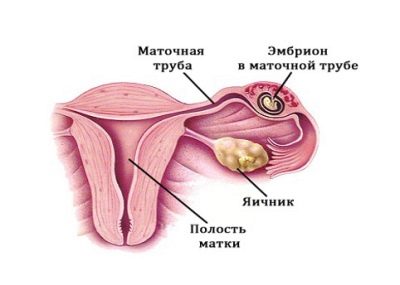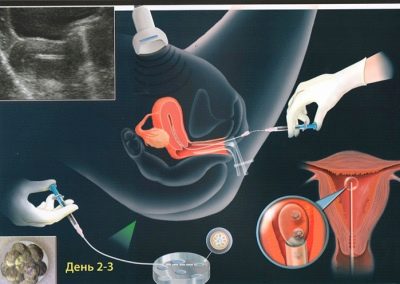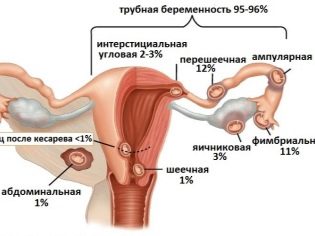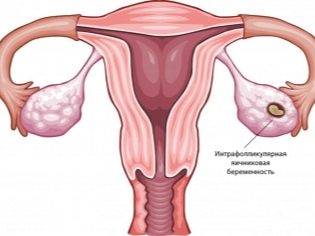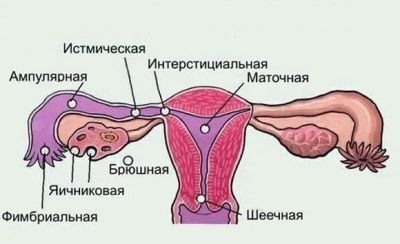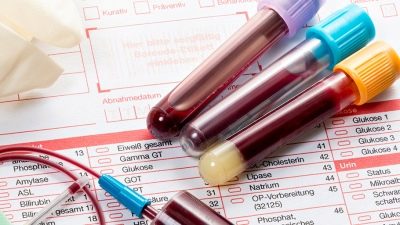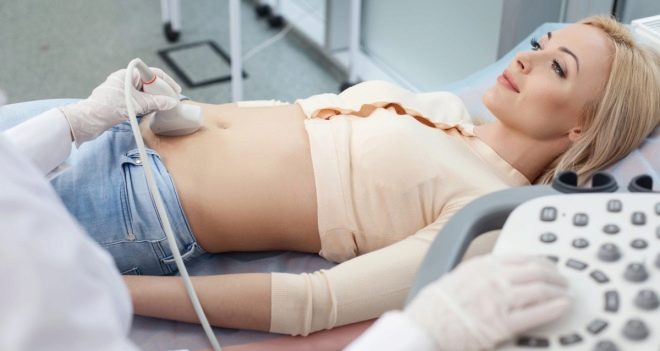Can there be an ectopic pregnancy in IVF and what causes it can cause?
In the overwhelming majority of cases, an ectopic pregnancy occurs at conception in a natural way, since during IVF (in vitro fertilization) embryos are transferred directly into the uterus. However, in rare cases, they can move to another part of the body for a number of reasons, due to which an ectopic pregnancy occurs. What factors provoke the development of a similar pathology in IVF? How can it be avoided? We will tell about it in our article.
Development mechanism
The merger of male and female germ cells occurs most often in the fallopian tube, from where the zygote moves into the uterine cavity. If for some reason she does not reach the endometrium, then an ectopic pregnancy develops. This process is characteristic of conceiving naturally.
Could this happen with IVF? First you need to find out what is this procedure. In vitro fertilization is different from the natural in that it occurs not in the mother's body, but in the laboratory. Unfortunately, there is no 100% guarantee that after carrying out this procedure, a woman will definitely become a mother.
The decisive influence on the success of the manipulation is exerted by the physical condition of the future father and mother, the endocrine balance of the woman’s body, as well as her attitude. In addition, an important role in this matter is played by the choice of the specialist who will perform this manipulation. It is also necessary to take into account a number of features of preparation for the procedure and precisely perform a step-by-step algorithm of actions.
Since IVF fertilization occurs outside the mother's body, and after that the fetus is transplanted into the uterus, it may seem that an ectopic pregnancy will not occur in this case. However, this opinion is wrong. Until the fertilized egg is implanted in the uterine mucosa, it “floats” and can consolidate in other parts of the organ, such as the fallopian tubes, ovaries, or cervix. Outside the body of the uterus, the embryo is viable up to a certain point (as long as it has, where to grow), therefore it is not possible to maintain this pregnancy.
With IVF, a heterotopic pregnancy can occur, which is characterized by the development of embryos in the uterus and in the tube at the same time. This is due to the fact that with artificial insemination several embryos are transferred to the uterus at once, in order to increase the chances of a successful outcome. But at the same time, the transferred embryos wander into the uterus before being introduced into the endometrium, and one of them can leave its limits.
In this case, it is possible to maintain only a normal pregnancy, while the surgeon will have a difficult task: remove the fallopian tube with the embryo and not harm the normal pregnancy.
According to specialists in the field of reproductive health, the probability of developing an ectopic pregnancy after an IVF procedure is approximately 3-10%. If a woman who is forced to use the IVF procedure has the fallopian tubes removed, this does not exclude the possibility of developing an ectopic pregnancy. This is due to the fact that during the operation the tubes are not completely excised, and there always remains a small area near the entrance to the uterus.The embryo has the ability to implant on the border of the uterus and the remaining segment or in another part, for example, on the neck.
Classification
Ectopic pregnancy on the localization of the embryo is divided into several types.
- Pipe type. It occurs in 95-97% of patients diagnosed with an ectopic pregnancy. This type is characterized by implantation of a zygote into the cavity of one of the fallopian tubes. The development of the embryo occurs before its rupture.
- Ovarian type. This type of ectopic pregnancy can be attributed to extremely rare clinical cases, since it occurs only in 1-2%. Ovarian pregnancy is a consequence of the implantation of the embryo into the structure of the ovary.
- Abdominal type. This type of ectopic pregnancy can also be attributed to the rarely diagnosed. This pathology is characterized by the entry of a fertilized egg into the abdominal cavity.
- Stitches Characterized by the attachment of a fertilized egg in the space between the large ligaments of the uterus. If the interlinkage pregnancy has not been interrupted in the early stages of gestation, then its development may be delayed until approximately 20 weeks.
- Neck type Due to the implantation of the embryo in the cervical region. Until a certain moment, such a pregnancy has no objective symptoms. However, in the later stages, vaginal secretions may occur with an admixture of blood, especially after sexual intercourse.
- Interstitial type. Characterized by the implantation and development of the embryo in the interstitium of the fallopian tubes. If such a pregnancy is not interrupted at the initial stages of development, then it can develop up to a 4-month period.
Each of these types of ectopic pregnancy is considered an extremely dangerous condition that can cause rupture of the fallopian tube, ovary and other organic structures, as well as cause severe bleeding.
Etiology
The most common causes of pregnancy outside the uterus after IVF may be following factors:
- non-observance of bed rest after the procedure of artificial insemination and other recommendations of the doctor;
- trauma of the fallopian tubes by hyperstimulation;
- artificial abortion and diagnostic curettage in history;
- the presence of inflammatory diseases of the appendages and uterus;
- chronic endometriosis;
- use of the IUD (intrauterine device);
- stresses.
As you can see, among the factors predisposing to the development of ectopic pregnancy are quite common states. Therefore, during the IVF procedure, careful medical supervision of the patient by the staff of the antenatal clinic is necessary.
Diagnostics
A woman after the IVF procedure carefully listens to her feelings. If she begins to feel weakness, dizziness, nausea, and any pain in the lower abdomen, this may indicate an ectopic pregnancy. When examined by a gynecologist, this pathology can be identified in case of intense abdominal pain and a significant increase in the uterus.
In order to prevent rupture of the tubes and the development of massive internal bleeding, it is necessary to immediately seek help from specialists when these symptoms appear. After the IVF procedure, the woman is constantly under medical supervision, so do not hesitate to talk about all the unusual sensations.
With an ectopic pregnancy, a blood test for the concentration of progesterone hormones and hCG will be reduced almost by half compared with the characteristics typical of normal pregnancy. It is necessary to take it every two days to make an accurate diagnosis.
Very often, in the presence of threatening signs, doctors resort to surgical laparoscopy. This is a diagnostic procedure that is carried out through small incisions in the front wall of the abdomen with the help of special optical instruments.It allows you to accurately and quickly diagnose. With this manipulation, it is possible to visualize the abdominal organs, assess their condition, and remove the existing adhesions and embryo from the fallopian tube. In case of rupture of the tubes and massive internal bleeding, laparoscopy is not used, and doctors perform abdominal surgery.
Therapy methods
For the treatment of ectopic pregnancy mainly used surgical method. With this diagnosis it is also possible to use elements of conservative treatment: drugs are prescribed that inhibit the growth of the ovum and the embryo. Drug therapy is not popular, as it is carried out with the help of toxic drugs. After such treatment, serious complications can occur.
The type of surgical treatment is determined only by the attending physician, depending on the specific case. He also decides to remove the fallopian tube or save it. If it is possible to do without complete excision of the tube, the surgeon will carefully open it and take out the embryo.
Currently, the so-called access method is widely used, thanks to which it is possible to preserve the fallopian tube in the presence of tubal pregnancy. In this case, only the fertilized egg is removed.
For this purpose, you can use different surgical techniques. However, such a manipulation has a significant drawback: after its implementation, there remains the threat of a recurrence of ectopic pregnancy during IVF. Therefore, in most cases, the fertilized egg is removed along with the fallopian tube so that such situations do not arise in the future.
If the embryo develops in the abdominal cavity, then it is impossible to do without prompt removal. This type of ectopic pregnancy is registered extremely rarely (in 0.02% of cases), and usually occurs as a result of an improperly performed embryo grafting procedure. There are entire forums dedicated to the discussion of this problem. On them, women share real reviews regarding the treatment of ectopic pregnancy.
Rehabilitation
If it was possible to restore all the organs after the operation, then no one will guarantee that if the embryos are replanted again, an ectopic pregnancy does not occur. Therefore, it is extremely important to undergo a full course of therapy and rehabilitation. After surgery, follow-up protocols should be postponed for at least 6 months.
After surgery, a woman should spend more time outdoors and move. For six months, sexual relations should be only with the use of contraceptives. Immediately after the operation, the patient is prescribed procedures to restore the reproductive function, for example, hydroturbation. During this procedure, special preparations are introduced into the fallopian tubes, which have a regenerating effect and accelerate the regeneration of damaged tissues. If there are any spikes in the pipes, they can be removed using laser polishing.
Prevention
To avoid ectopic pregnancy is quite possible, if you strictly follow the recommendations of the doctor. This is especially true of bed rest immediately after embryo transfer.
Two weeks after embryo transfer, it is necessary to pass an analysis for the content of hCG (a hormone that produces the placenta). The growth of this indicator is a sign of pregnancy, so after 10 days an ultrasound should be done to determine where the embryo is located.
It so happens that during an ultrasound scan, a doctor can see the fertilized egg in the uterus during the 3-4 weeks of gestation (in case of uterine pregnancy). In the absence of an embryo in the uterus within a certain time after the transfer of the ovum, a positive pregnancy test, an increase in the concentration of hCG in the blood,the appearance of bloody vaginal discharge and the presence of pain in the lower abdomen can be very likely to assume ectopic pregnancy.
IVF is a rather complicated procedure that requires a responsible approach from both the specialists who carry out all the manipulations and the woman who wants to experience all the delights of motherhood. That is why careful monitoring of the patient's physiological parameters is of great importance.
If a woman complains about the appearance of symptoms indicating the possible development of an ectopic pregnancy, and the doctor, in turn, during an objective examination reveals signs confirming the presence of this pathology, then the question is raised about the patient's hospitalization and a comprehensive examination.
In such a situation, a delay in going to a doctor can be very dangerous, since an ectopic pregnancy is fraught with the risk of rupture of the fallopian tube, which is a very serious condition that, if not provided with timely assistance, could be fatal.
The reasons for the appearance of an ectopic pregnancy with IVF are discussed by a specialist in the next video.

